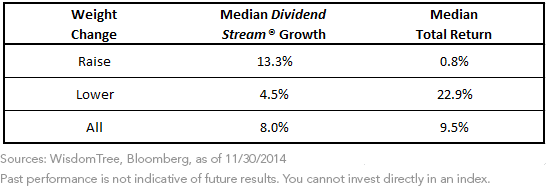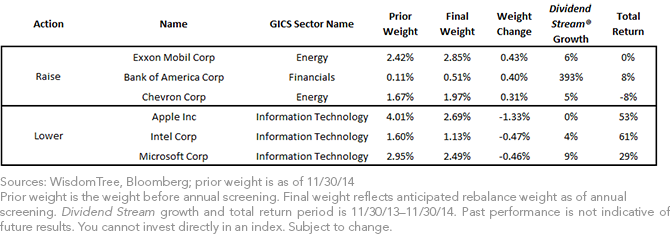Managing Valuation Risk by Rebalancing


 For definitions of terms in the chart, please visit our glossary.
• Dividend Growers Saw Weight Increase: The companies that saw their weight increase at the rebalance had a median dividend growth of 13.3%, which was greater than the median dividend growth of all companies (at 8.0%). Companies that saw their weight lowered at the rebalance had a median dividend growth of just 4.5%.
• Underperformers Typically Saw Weight Increase: Performance is also a key driver of relative changes. The typical stock that saw its weight increase had a median total return that was over 8 percentage points lower than the median of all stocks.
• Outperformers Reduced at Rebalance: The typical stock that saw its weight lowered at the rebalance had a median total return 13 percentage points above all stocks. This is one of the keys to managing valuation risks.
A Detailed Look at the Individual Drivers
The above was a higher-level overview of the total Index, but in figure 2, we highlight a few of the top additions and deletions to further specify the contributors.
Figure 2: WisdomTree Dividend Index (WTDI) Details
For definitions of terms in the chart, please visit our glossary.
• Dividend Growers Saw Weight Increase: The companies that saw their weight increase at the rebalance had a median dividend growth of 13.3%, which was greater than the median dividend growth of all companies (at 8.0%). Companies that saw their weight lowered at the rebalance had a median dividend growth of just 4.5%.
• Underperformers Typically Saw Weight Increase: Performance is also a key driver of relative changes. The typical stock that saw its weight increase had a median total return that was over 8 percentage points lower than the median of all stocks.
• Outperformers Reduced at Rebalance: The typical stock that saw its weight lowered at the rebalance had a median total return 13 percentage points above all stocks. This is one of the keys to managing valuation risks.
A Detailed Look at the Individual Drivers
The above was a higher-level overview of the total Index, but in figure 2, we highlight a few of the top additions and deletions to further specify the contributors.
Figure 2: WisdomTree Dividend Index (WTDI) Details
 • Energy Earned Largest Increase: The biggest increase in weight for any sector in WTDI occurred in Energy—an increase of 1.7%, which was driven primarily by its poor performance over the period. As figure 2 shows, Exxon and Chevron contributed to this increase in weight, having grown their dividends faster than their prices over the period, ultimately improving the fundamental relationship between price and dividends.
• Financials Led Dividend Stream® Growth: Over the period, the Financials sector displayed the strongest percentage growth, earning the sector a 1.3% increase in weight in WTDI. Bank of America saw the largest increase in weight in the sector after increasing its dividend per share fivefold over the year, from $0.01 to $0.05, which translated to a Dividend Stream growth of almost 400%.
• Information Technology Saw Its Weight Lowered: The biggest decrease in weight for any sector in WTDI occurred in Information Technology—a decrease of 2.4%, which was driven primarily by its strong performance over the period. As noted in figure 2, Apple, Intel and Microsoft all helped contribute to this decrease in weight, having grown their dividends more slowly than their prices over the period, thus ultimately decreasing the fundamental relationship between price and dividends.
Importance of Incorporating a Relative Rebalance
The WisdomTree annual rebalance is a key element of the added value of WisdomTree’s Index methodology and can help manage valuation risks. WisdomTree Indexes use dividend growth as a key factor in determining which companies get increased weight at a rebalance. We interpret another year of double-digit dividend growth as a very positive indicator of underlying market fundamentals and believe it helps provide a notable foundation for potential future gains.
For current holdings of the WisdomTree Dividend Index, please click here.
1The overall universe is defined as the WisdomTree Dividend Index (WTDI)
• Energy Earned Largest Increase: The biggest increase in weight for any sector in WTDI occurred in Energy—an increase of 1.7%, which was driven primarily by its poor performance over the period. As figure 2 shows, Exxon and Chevron contributed to this increase in weight, having grown their dividends faster than their prices over the period, ultimately improving the fundamental relationship between price and dividends.
• Financials Led Dividend Stream® Growth: Over the period, the Financials sector displayed the strongest percentage growth, earning the sector a 1.3% increase in weight in WTDI. Bank of America saw the largest increase in weight in the sector after increasing its dividend per share fivefold over the year, from $0.01 to $0.05, which translated to a Dividend Stream growth of almost 400%.
• Information Technology Saw Its Weight Lowered: The biggest decrease in weight for any sector in WTDI occurred in Information Technology—a decrease of 2.4%, which was driven primarily by its strong performance over the period. As noted in figure 2, Apple, Intel and Microsoft all helped contribute to this decrease in weight, having grown their dividends more slowly than their prices over the period, thus ultimately decreasing the fundamental relationship between price and dividends.
Importance of Incorporating a Relative Rebalance
The WisdomTree annual rebalance is a key element of the added value of WisdomTree’s Index methodology and can help manage valuation risks. WisdomTree Indexes use dividend growth as a key factor in determining which companies get increased weight at a rebalance. We interpret another year of double-digit dividend growth as a very positive indicator of underlying market fundamentals and believe it helps provide a notable foundation for potential future gains.
For current holdings of the WisdomTree Dividend Index, please click here.
1The overall universe is defined as the WisdomTree Dividend Index (WTDI)Important Risks Related to this Article
Dividends are not guaranteed and a company’s future ability to pay dividends may be limited. A company currently paying dividends may cease paying dividends at any time.

Jeremy Schwartz has served as our Global Chief Investment Officer since November 2021 and leads WisdomTree’s investment strategy team in the construction of WisdomTree’s equity Indexes, quantitative active strategies and multi-asset Model Portfolios. Jeremy joined WisdomTree in May 2005 as a Senior Analyst, adding Deputy Director of Research to his responsibilities in February 2007. He served as Director of Research from October 2008 to October 2018 and as Global Head of Research from November 2018 to November 2021. Before joining WisdomTree, he was a head research assistant for Professor Jeremy Siegel and, in 2022, became his co-author on the sixth edition of the book Stocks for the Long Run. Jeremy is also co-author of the Financial Analysts Journal paper “What Happened to the Original Stocks in the S&P 500?” He received his B.S. in economics from The Wharton School of the University of Pennsylvania and hosts the Wharton Business Radio program Behind the Markets on SiriusXM 132. Jeremy is a member of the CFA Society of Philadelphia.

